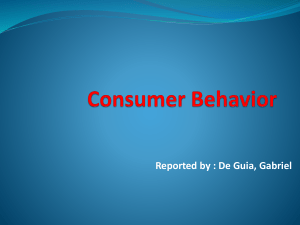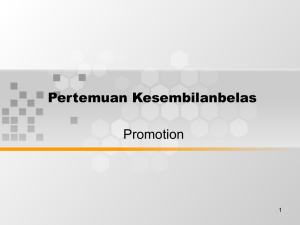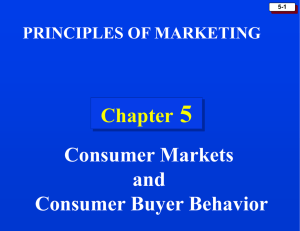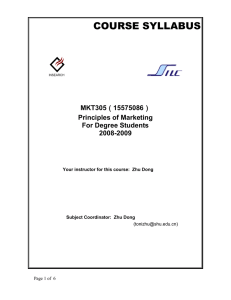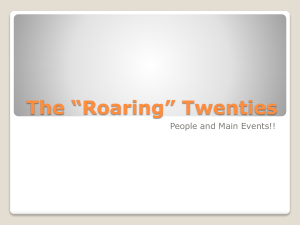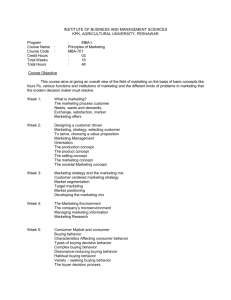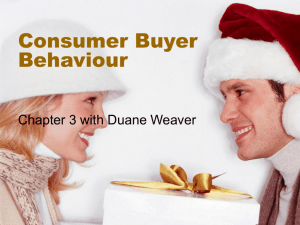Uploaded by
Lucas McCammond Moran
Strategic Marketing: Consumer Behavior & Decision Process
advertisement
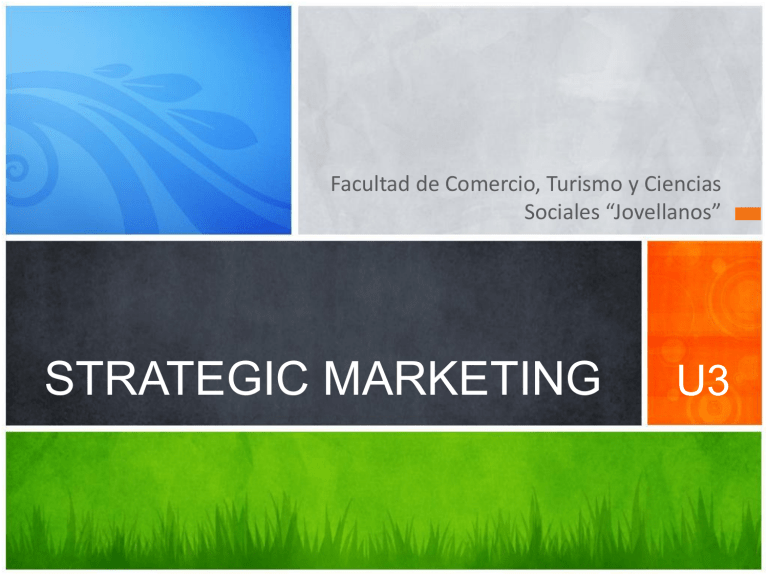
Facultad de Comercio, Turismo y Ciencias Sociales “Jovellanos” STRATEGIC MARKETING U3 T3 Consumer markets TOC 3.1 Characteristics affecting consumer behavior 3.2 The buyer decision process 3.3 Types of buying decision behavior 3.0 Two Preliminary questions The black box 3.1 Characteristics affecting consumer behavior • Two preliminary questions: – What is a consumer market? • All of the personal consumption of final consumers • Difference with an industrial / institutional / organizational market? – What is consumer purchase behavior? • The buying behavior of final consumers, individuals and households, who buy goods and services for personal consumption 3.1 Characteristics affecting consumer behavior The black box 3.1 Characteristics affecting consumer behavior • A model of consumer behavior: Cultural Factors Culture, Subculture and Social Class 3.1 Characteristics affecting consumer behavior 3.1 Characteristics affecting consumer behavior • Culture: – the learned values, perceptions, wants, and behavior from family and other important institutions • Subcultures: – groups of people within a culture with • shared value systems based on • common life experiences and situations 3.1 Characteristics affecting consumer behavior • Social Class: – Society’s relatively permanent and ordered divisions whose members share similar values, interests, and behaviors – Question for discussion: • Which are the antecedents of (how can we determine) social class? – – – – – ______________________ ______________________ ______________________ ______________________ ______________________ Social Classes in U.K. and the U.S.A. Higher Managerial and professional occupations Upper class (3%) • Employers and managers in large organisations • Higher professionals • Upper Uppers 1% (inherited wealth) • Lower Uppers 2% (high income through exceptional ability) Lower managerial and professional occupations Intermediate occupations Small employers and sole traders Lower supervisory, craft and related occupations Semi-routine occupations Routine occupations Middle class (44%) • Upper middles 12% (professionals, independent business persons, corporate managers) • Middle class 32% (average workers that live in the better side of the town Working class (38%) Lower class 16% • Upper lowers 9% lack education and are poorly paid for unskilled work • Lower lowers 7% are visibly poor, often out of work and depend on public assistance Social Factors Reference Groups, Family, Roles and Status 3.1 Characteristics affecting consumer behavior • Reference Groups: – They influence our behavior – Primary or Secondary – New kid on the block?: social networks. Membership Groups • Groups with direct influence and to which a person belongs Aspirational Groups • Groups an individual wishes to belong to Reference Groups • Groups that form a comparison or reference in forming attitudes or behavior 3.1 Characteristics affecting consumer behavior • Family is the most important consumer-buying organization in society – Family of orientation – Family of procreation • Consumer buying roles within the family: – – – – – Initiator Influencer Decider Buyer User Personal Factors Age and life cycle stage, Occupation, Economic Situation, Lifestyle, Personality and Self Concept 3.1 Characteristics affecting consumer behavior • Single • Married without children • Married with children • Married without dependent children • Divorced without children • Divorced with children • Divorced without dependent children Elder • Single • Married without children • Married with children • Divorced with children Middle aged Young • Personal: Age and life cycle stage • Older married • Older unmarried 3.1 Characteristics affecting consumer behavior • Occupation: – Blue collar – White collar • Economic Situation: 3.1 Characteristics affecting consumer behavior • Lifestyle: – A person’s pattern of living as expressed in his/her activities, interests and opinions. • Lifestyle classifications: – SRI VALS (nine categories) – SINUS GmbH: • • • • • Traditional values • Hard work, thrift, religion, honesty, good manners and obedience Material values Basic Orientation: traditional (to preserve) • Possesion and need for security Basic Orientation: materialist (to have) Changing Values: hedonism (to indulge) Changing Values: postmaterialism (to be) Changing Values: postmodernism (to have, to be and to indulge) 3.1 Characteristics affecting consumer behavior Upper Conservatives • Traditional upper-middle class conservatives Traditional Mainstream • Petit bourgeois group mainly oriented to preserving the status quo Traditional Working Class • Traditional blue collar workers Modern Mainstream • Social climber and acheivement-oriented white and blue collar workers Trendsetter • Technocratic liberals with a postmaterial orientation Avantgarde • Mainly yound pleasure seekers Sociocritical • Pursuing an alternative lifestyle Under-privileged • Uprooted blue-collar workers and destitute 3.1 Characteristics affecting consumer behavior • Personality: – Unique psychological characteristics that lead to relatively consistent and lasting responses to one’s own environment: • • • • • • • Self-confidence Dominance Sociability Autonomy Defensiveness Adaptability Aggressiveness • Self-Concept: – How do we see ourselves (actual self-concept) – How would we like to be seen by others (ideal self-concept) Psychological Factors Motivation 3.1 Characteristics affecting consumer behavior • Motivation: – A need becomes a motive when it is aroused to a sufficient level of intensity – The battle between Freud and Maslow Psychological Factors Motivation 3.1 Characteristics affecting consumer behavior • Perception: – Process by which people select, organize, and interpret information to form a meaningful picture of the world from three perceptual processes. – Key concepts: • Selective attention • Selective distortion • Selective retention • Learning: – Change in an individual’s behavior arising from experience and occurs through interplay of: • • • • • Drives Stimuli Cues Responses Reinforcement The process of learning • 1) A friend invited us for dinner at his/her place – Damn! I should provide something for the dinner. (That’s a DRIVE) • 2) While reading the newspaper: – Look!, there’s an article about a wine called Luis Cañas Crianza 2009 that has been named “Wine with the best QPR in the world” by The Wine Advocate. (That’s an STIMULI) • 3) In the shop: – You do not find the aforementioned wine, but you start looking at other bottles of wine, and pay attention to words as “Rioja”, “Ribera del Duero” “Crianza”, “Reserva” or “Tempranillo”. (Those are CUES). • 4) You purchase: – One bottle of Herencia Remondo La Montesa 2009. (That’s your RESPONSE) • 5) You provide: – The wine for the dinner and everybody loves it. (Your behaviour has been REINFORCED) 3.1 Characteristics affecting consumer behavior • Beliefs: – a descriptive thought that a person has about something based on: • Knowledge • Opinion • Faith • Attitudes: – describe a person’s relatively consistent evaluations, feelings, and tendencies toward an object or idea 3.2 The buyer decision process If we have a buyer, we have a process 3.2 The buyer decision process • A process with five stages: 3.2 The buyer decision process • Need recognition: – Buyer senses a difference between an actual state and some desired state, triggered by: • Internal stimuli • External stimuli Marketers want to understand the factors and situations that usually trigger consumer need recognition. 3.2 The buyer decision process • Information Search: – So, consumer has a need. Three outcomes: • 1) strong drive, satisfying product at hand… just purchase it. • 2) just store the need in memory (heightened attention) • 3) let’s search for information on how to solve my need (active search) – Sources for information: • • • • Personal sources: family, friends, neighbors… Commercial: advertising, salespeople, Internet, packaging, displays Public sources: mass media, consumer-rating organizations Experiential sources: handling, examining and using the product Marketers want to understand where do customers get their information, and how they trust it depending on the source. 3.2 The buyer decision process • Evaluation of alternatives: – How do consumer process information to arrive at brand choices. – Certain needs take consumers to value certain product benefits. – Consumers attach different degrees of importance to each attribute. • The difference between “importance” and “saliency” – Consumers develop brand beliefs – Consumers have a utility function for each attribute – Models: • Expectancy value model of consumer choice (composite index of attributes x importance) • Conjunctive models: my choice must have this attribute • Disjunctive model: my choice should rank high in this attribute Marketers want to understand how consumers evaluate alternatives 3.2 The buyer decision process • Purchase Decision: – After evaluation, the preferred brand is most likely to be purchased. – But: • It can also be postponed • Decision can be influenced by: – Other people – Situational determinants – Perceived risk poses several threats in this stage Marketers want to understand why consumers engage in exchange, and how those exchanges are created, resolved or avoided. Déjà-vu? 3.2 The buyer decision process • Post-Purchase Behavior: – Comparison between expectations and perceived performance. – Size of the gap determines levels of: • Satisfaction • Dissatisfaction – Cognitive dissonance: discomfort caused by post-purchase conflict. – The double speed magnitude: WOM 3.2 The buyer decision process If consumers are not buying a product because they do not perceive a need for it, Marketing might launch advertising messages that trigger the need and show how the product solves customer’s problems. If customers know about the product but are not buying because they hold unfavourable attitudes towards it, the marketer must find ways either to change the product or to change consumer perceptions. 3.3 Types of buying decision behavior If we have a buyer, we have a process 3.3 Types of buying decision behavior • A toothpaste is not a tennis racket, an expensive camera or a new car. • Complex decisions involve: – More buying participants – More buyer deliberation • Classification: 3.3 Types of buying decision behavior • Complex Buying Behavior – High involvement in a purchase – Significant differences among brands – Product is: • • • • Expensive Risky, Purchased infrequently Highly self-expressive 3.3 Types of buying decision behavior • Dissonance-reducing buying behavior: – High involvement – Product is: • Expensive • Infrequent to purchase • Not big difference among brands – Important drives: • Good price • Convenience • Brand recognition -> reduces dissonance 3.3 Types of buying decision behavior • Habitual buying behavior – – – – – Low involvement Little brand difference Brand choice can be habit more than preference It is more about brand familiarity than brand conviction Price and sale promotions are very strong drives 3.3 Types of buying decision behavior • Variety-seeking behavior: – Low involvement – Significant perceived differences between brands. – Consumers do a lot of brand switching: • Boredom • For the fun of trying something different Typical strategies – Brand leaders try to promote habitual behavior by dominating shelf-space, advertising and avoiding out-of-stock conditions. – Brand challengers will encourage variety seeking by offering lower prices, deals, coupons, free samples and advertising centering on the fun of trying something new. 3.3 Types of buying decision behavior If we have a buyer, we have a process
